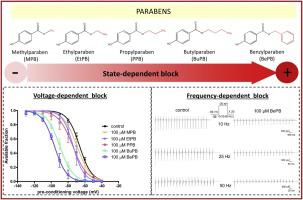Biomedicine & Pharmacotherapy ( IF 6.9 ) Pub Date : 2020-05-29 , DOI: 10.1016/j.biopha.2020.110250 Andrea Enrique 1 , Pedro Martín 1 , María Laura Sbaraglini 2 , Alan Talevi 2 , Verónica Milesi 1

|
Propylparaben, a commonly used antimicrobial preservative, has been reported as an anticonvulsant agent targeting neuronal Na+ channels (NaV). However, the specific features of the NaV channel inhibition by this agent have so far not been extensively studied. Moreover, it is still unclear if it shares this pharmacological activity with other parabens. Here, we fully characterized the mechanism of action of the inhibitory effect that propylparaben and benzylparaben induce on human NaV 1.2 channel isoform (hNaV1.2). We established a first approach to know the parabens structural determinants for this channel inhibition. The parabens effects on hNaV1.2 channel mediated currents were recorded using the patch-clamp whole-cell configuration on hNaV1.2 stably transfected HEK293 cells. Propylparaben induced a typical state-dependent inhibition on hNaV1.2 channel carried current, characterized by a left-shift in the steady-state inactivation curve, a prolongation in the time needed for recovery from fast inactivation and a frequency-dependent blocking behavior. The state-dependent inhibition is increased for butylparaben and benzylparaben and diminished for methylparaben, ethylparaben and p-hydroxybenzoic acid (the major metabolite of parabens hydrolysis). Particularly, butylparaben and benzylparaben shift the steady-state inactivation curve 2- and 3-times more than propylparaben, respectively. Parabens are blockers of hNaV1.2 channels, sharing the mechanism of action of most of sodium channel blocking antiseizure drugs. The potency of this inhibition increases with the size of the lipophilic alcoholic residue of the ester group. These results provide a basis for rational drug design directed to generate new potential anticonvulsant agents.
中文翻译:

对羟基苯甲酸酯抑制hNaV 1.2通道。
对羟基苯甲酸丙酯,一种常用的抗菌防腐剂,已被报道为靶向神经元Na +通道(Na V)的抗惊厥药。然而,迄今为止尚未广泛研究该试剂抑制Na V通道的具体特征。而且,还不清楚它是否与其他对羟基苯甲酸酯有这种药理活性。在这里,我们充分表征了对羟基苯甲酸丙酯和对羟基苯甲酸苄酯对人Na V 1.2通道亚型(hNa V 1.2)的抑制作用的作用机理。我们建立了第一种方法来了解对羟基苯甲酸酯结构决定因素对此通道的抑制作用。对羟基苯甲酸酯类对hNa V的影响使用膜片钳全细胞配置在hNa V 1.2稳定转染的HEK293细胞上记录了1.2通道介导的电流。尼泊金丙酯对hNa V 1.2通道携带的电流具有典型的状态依赖性抑制,其特征在于稳态灭活曲线向左移动,从快速灭活中恢复所需的时间延长以及频率依赖性阻断行为。对羟基苯甲酸丁酯和对羟基苯甲酸苄酯的状态依赖性抑制作用增强,而对羟基苯甲酸甲酯,对羟基苯甲酸乙酯和对羟基苯甲酸(对羟基苯甲酸酯水解的主要代谢产物)的抑制作用减弱。特别地,对羟基苯甲酸丁酯和对羟基苯甲酸苄酯的稳态灭活曲线分别比对羟基苯甲酸丙酯移动2倍和3倍。对羟基苯甲酸酯是hNa的阻滞剂V 1.2通道,共享大多数钠通道阻滞抗癫痫药物的作用机理。这种抑制的效力随着酯基团的亲脂性醇残基的大小而增加。这些结果为旨在产生新的潜在抗惊厥药的合理药物设计提供了基础。
















































 京公网安备 11010802027423号
京公网安备 11010802027423号